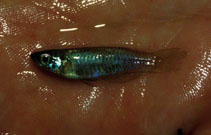| Family: |
Procatopodidae (African lampeyes), subfamily: Procatopodinae |
| Max. size: |
4 cm TL (male/unsexed); 4 cm TL (female) |
| Environment: |
benthopelagic; freshwater; pH range: 6.5 - 7.19999980926514, potamodromous |
| Distribution: |
Africa: lower Volta, Dayi and Ofu rivers in Ghana (Ref. 57259); Sassandra, Comoé, Bandama and Cavally rivers in Côte d'Ivoire (Ref. 57259); St. John's and Douobe rivers in Liberia (Ref. 57259). There is also an unconfirmed record in the Volta River in Burkina Faso (Ref. 57259). |
| Diagnosis: |
Dorsal spines (total): 0-0; Dorsal soft rays (total): 8-12; Anal spines: 0-0; Anal soft rays: 13-17. Diagnosis: A ‘lampeye’ species of moderate size with relatively long, truncated or rounded unpaired fins; dorsal fin with 8-12 rays, anal fin with 13-17 rays, displacement between dorsal and anal fins 1/5-8; scales on mid-lateral series 25-27 (Ref. 57259).
Colouration: Male colouration: overall body colour is grey to pale olive with a strong light blue iridescence on the sides; the iridescence is especially prominent in the region between the eye and the frontal base of the dorsal fin; the scales on the sides and back have narrow brown to dark grey borders, producing a reticulated appearance; the colour of the unpaired fins is highly variable, depending on the population, and may be yellow, orange or red; some populations display red or brown margins on the unpaired fins; also variable between populations is the presence or absence of spots on the unpaired fins; when present, these are arranged in vague lines in the dorsal and anal fins, and in crescent-shaped bars in the caudal fin (Ref. 57259). Female colouration: translucent grey overall, brown on the back and silver in the abdominal region; the unpaired fins are colourless or pale yellow; the anal fin is relatively long and somewhat pointed (Ref. 57259). Both sexes have a distinct light blue reflecting spot in the upper part of the iris (Ref. 57259). |
| Biology: |
Found in small rivers, brooks and swamps of the forested savannah (Ref. 3788, 57259). Not a seasonal killifish. Is difficult to maintain in aquarium (Ref. 27139). |
| IUCN Red List Status: |
Least Concern (LC); Date assessed: 30 November 2019 Ref. (130435)
|
| Threat to humans: |
harmless |
Source and more info: www.fishbase.org. For personal, classroom, and other internal use only. Not for publication.

